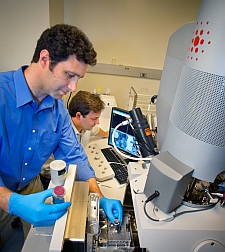Scientists at Lawrence Berkeley National Lab, University of California at Berkeley, and Los Alamos National Lab have devised a testing technique for irradiated materials at nanoscale that offers insights into the full-scale properties of those materials. The team’s findings appear in the current online issue of the journal Nature Materials (paid subscription required).
The technique developed by the national labs/university team involves testing materials’ properties at nanoscale, where one nanometer is equal to one billionth of a meter. The new process can speed development of materials for nuclear applications and reduce the amount of material required for testing of facilities already in service.
The problem faced by materials scientists is that testing properties at nanoscale had previously returned higher strengths than at full scale. The new techniques, however, show that real properties of materials can be detected from irradiated specimens as small as 400 nanometers in diameter, according to Andrew Minor, a faculty scientist in the National Center for Electron Microscopy (NCEM) and the materials science and engineering department at UC Berkeley.
In this study, Minor’s team conducted compression tests of copper specimens irradiated with high-energy protons, to model the effects of radiation on mechanical properties of copper. Three-dimensional defects in copper created by radiation, called dislocations, can block the motion of one-dimensional defects in the crystal structure of the metal. This interaction causes irradiated materials to become brittle, and alters the amount of force a material can withstand before it eventually breaks.
The research team used a testing device in a transmission electron microscope at NCEM that revealed with nanoscale resolution the nature of the deformation and its restriction to just a few atomic planes.
By translating nanoscale strength values into bulk properties, this technique could help reactor designers find suitable materials for engineering components in nuclear plants. “This proof of principle study gives us a model system from which we can now start to explore real, practical materials applicable to nuclear energy,” says Minor.
But one immediate benefit is in the testing lab itself. Co-author Peter Hosemann, in the nuclear engineering department at UC Berkeley notes, “By using a smaller specimen, we limit any safety issues related to the handling of the test material.”
Read more: Researchers Find New Properties in an Old Material
* * *


 RSS - Posts
RSS - Posts
[…] Read more: Nanoscale Nuclear Testing Capability Developed […]